In the problem "how to determine the angle of the roof slope", there are many unknowns.
A solution for each of them can be found in this article.
It is not for professionals. It is for those who are ready or have already embarked on mastering the uneasy profession of the builder.
All he needs is an opportunity to finance the future project and the enthusiasm of the pioneer in a new business for himself.
The rest will be told in the future.
The roof is not only a beautiful element of a house under construction.
This is his long and comfortable existence.
A warm, cozy and dry building for many years is the main motto of a good roof.
Before you decide on a particular roof construction, its future owner considers a lot.
There are many of them and all of them have weighty arguments in favor of their existence:
- Flat roofs with a slope angle of up to 0. Widely used in typical civil and industrial construction. Demand a complex, engineering storm drainage system. Regular cleaning from snow and debris is necessary.
- Pitched structures are practical and functional. Depending on the chosen angle of inclination are self-cleaning. Provide an opportunity to use the under-roof space for various purposes. At the same time, they are complex and expensive to manufacture. Great costs when repairing them.
In turn, pitched roofs can be both bescherdachnymi (mansard) and attic:
- For the attic version, their further destination is very important, with or without use.
- For mansard - it will be broken or simple. With a broken version, it becomes necessary, in some way, to "outplay" the internal props.
These same designs can be single-slope and two-slope. Knowing how to determine the angle of inclination of a roof in degrees, it will be possible to apply modern ones. And also, the most optimal way to use the under-roof space, without deteriorating the structural characteristics of the structure:
- The hip variant is one of the most practical and sustainable. In this case, the 2 trapezia and 2-a pedimental triangles are connected in one ridge. When erecting requires professional experience and a sufficient carpentry skill.
- The semi-high-mast variant is when the gable roof triangles split into 2 parts. Each of these parts is at a certain angle to each other. With more complicated installation and increased costs, there are no additional benefits, apart from aesthetic impression.
- Hip-roof version of the hip roof - all the skates converge at one, the highest point. Rather design than a functional option. Good for homes that have a square in the plan or a regular one, a beautiful polygon. It is aesthetic and has good strength characteristics.
- Multiple roof construction - most often used for buildings with a complex polygon shape in plan. Characterized by a complex system of rafters and high cost. A precise calculation and a good design will emphasize the individuality of the building.
- Dome and cone roofs are rarely used types of roofs. Perhaps their application in the form of design solutions for the construction of complex compositions.
They cover only some parts of the building under construction - arches, entrances to, turrets.
Combined versions of all listed structures. This is the most complex, beautiful and expensive roof. Having a complex weir system, it is impractical during operation and difficult to repair.
What is a good roof? This is, above all, a sturdy construction, high thermal protection and a reliable resistance to atmospheric precipitation. If it is also beautiful, it means that the work is done for glory.
The angle of the ramp is dependent
Most of the newly erected buildings have their own peculiarities. It can be a unique, modern design of the whole country ensemble, excellent weather conditions.
In accordance with them, the architectural design of the main building is being developed. At the same time, the roof plays an important role in the formation of a general impression of the complex being built.
Introductory concepts for a beginner roof specialist
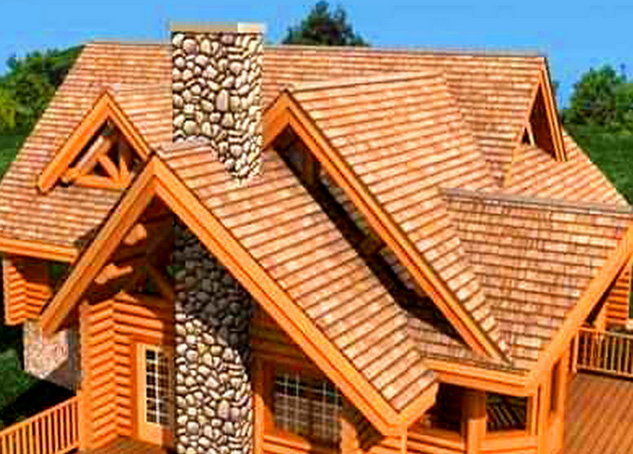
When designing a roof ensemble, the starting point of all strength calculations is the slope angle α of its rays.
This angle is taken to be measured in degrees at design and in percentage - at.
It is located between the slope itself and its horizontal projection.
For a flat roof, it is close to 0 0, with a cone - exceeds 45 0.
The percentage of the angle α is the ratio of the height of the pediment to the horizontal projection of the slope and multiplied by 100.
This indicator is convenient to use directly during construction, almost to the eye. No Bradys tables, calculators or smartphones.
Since the width of the house is known, then multiplying its half by the percent of the slope, we get a pediment. Pythagoras' theorem will allow us to calculate the size of rafters.
There is no need to use trigonometric formulas, as with degrees. It is well remembered and some relation between percentages and angles - 45 0 is 100%, and 30 0 - 57.7 0.
In other words, 1% is 27 '. The height of the pediment (katet) against the angle 30 0 is equal to half the rafters (hypotenuse).
In practice, builders rarely use such calculations. More commonly used ordinary string.
In the middle of the pediment, a long pole is beaten (strictly perpendicularly). One end of the twine is fixed on the edge of the gable, and the free end is lifted to the required height along the established rack.
The angle chosen in this way is measured with a protractor or a template is made. Having made a notch on the staff, they receive for the retaining racks of the skate.
Influence of external factors
Nothing will be worth knowing about how to determine the angle of the roof by eye, if you do not have an idea of the working conditions of the roof under construction. Any change in them immediately leads to the recalculation of "α". The most important of them are:
- Functional purpose of the under roof zone. If this zone will be used as a dwelling, then the angle of inclination selects the largest of the permissible variants, based on strength calculations. Otherwise, use the variant with a polyline construction. If it is a common attic, then do not "α" do more than 25 0.
- Wind load. With prevailing moderate winds (up to 15 m / s) the slope to 45 0 will be quite appropriate. If a gust of gust of great force (more than 20 m / sec) is possible, then you should not go beyond 25 0. In any case, it is necessary to use a map of wind pressure zones for information. Depending on the zone (from 1a to 5) of the location of the future building, one should also choose the roof structure.
- Precipitation. Using the map of snow pressure zones (8 zones with a load of 120 to 480 kg / m 2), we must compare the slope of the selected load with the correction factor. At "α" up to 25 0, the zone snow load remains unchanged (coefficient - 1). At its values from 25 0 and up to 60 0 - coefficient 0,7. If "α" is more than 60 0, the snow load is not taken into account.
- Materials of the top layer of the roofing pie. At a slope angle "α" up to 15 0, the overlay roll material is well worked, laid in 2 layers. At "α" up to 5 0 the number of layers should be increased to 3. Tiles and ordinary slate work well in the range from 20 0 to 45 0.
Correctly chosen angle not only optimizes all listed loads, but also in combination with roofing material will provide reliable protection of the house.
Basics of calculating the angle of inclination
One day all the procedures for identifying the harmful factors affecting the durability, stability and waterproofness of the future roof will end.
Loads are defined, selected, and the future destination of the under-roof space is assigned. It remains to calculate the angle α of the slope of rays:
- The wind load, in accordance with the map of wind pressure zones for the construction area, with gusts of no more than 15 m / sec, allows using the angle "α" to 45 0
- The snow pressure, in the 5th climatic zone, is 320 kg / m 2. For an angle of inclination up to 45 0, a reduction factor of 0.75 acts, which gives a specific load of 240 kg / m 2. Such a load will be used in the future to calculate the pitch and cross-section of the rafters.
Angle "α" = 45 0, with a house width of 9 m and ceiling height of 2 m, allows to obtain a vertical section of free space, under a gable, equal to 5.5 m 2. The height of the ridge is close to 5 m.
Having reduced the angle "α" to 35 0, the useful area will decrease to 3.5 m 2, which is quite acceptable. But at the same time, the height of the ridge will be reduced to 3.5 m and significantly - sail structure, cost, maintenance costs.
As a cover material, for a roof with a slope of 35 0, the most democratic will be slate, tinted according to the taste of the owner.
At the same time, it should be noted that at this angle of inclination, more modern materials can be used with success. For example, metal can be laid, starting with α = 10 0, but only the joints must be sealed. It will require an increased overlap.
Tiles of various compositions are applied at an angle greater than 20 °. The only thing that should be taken into account is that it is not light weight. The last remark restricts its use somewhat. But the service life deserves admiration - more than 60 years.
Flexible bituminous little will leave indifferent. Both in shape and color, it is suitable for roofing of any design. At an angle α ≥ 18 0 does not require additional waterproofing in the form of a backing layer.
But the roll bituminous material is not suitable for the chosen angle. Especially this applies to the southern side of the ramp. At high temperatures, it can simply slip.
We perform the calculation of the rafter's leg
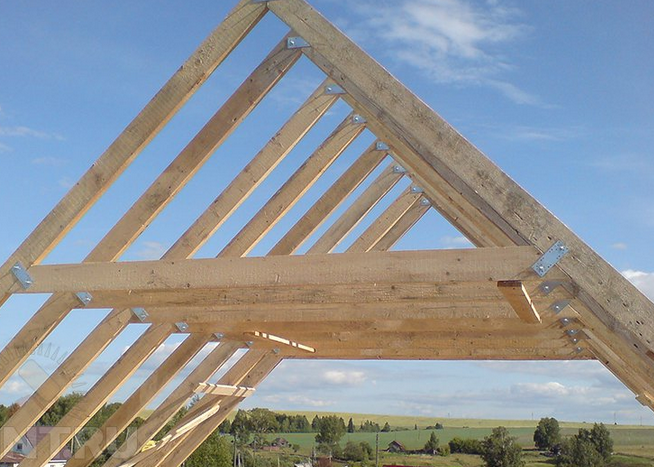
In accordance with the primary school course, the hypotenuse (rafter leg) is equal to the leg (half the width of the pediment) multiplied by cos α.
Or in mathematical form - L = l / 2: cos α.
Substituting the available data, we obtain L = 9/2: cos 35 0 = 4.5: 0.819152044 = 5.5 m.
Similarly, or by the Pythagorean theorem, it is possible to determine the height of the ridge racks.
It . With its help, you can design reliable and durable structures.
But this is the prerogative of experienced designers. For novice builders, it is important to have a representation and ability to use it.
Found an error? Select it and press Ctrl + Enterto let us know.
Roof of the house
The roof is a structural element of the building, which is responsible for protecting it from external factors. It must successfully withstand precipitation in the form of rain, hail, snow, heavy winds and destroying hurricanes. Correct slope of the roof plays a big role in the rapid removal from the roof of the water and the snow cover. In combination with a high-quality waterproofing, it provides excellent protection for the entire structure, including interior spaces.
From the competent slope of the roof will depend not only these indicators, but also its continued work and strength. How to make a calculation correctly, what factors to take into account, how to calculate it for roofs with different coatings - all these questions will be sanctified in this article.
On factors that affect the calculation of the angle of the roof slope
Roofs, as already written on our website, have different shapes and number of skates. They are one-, two- and four-sloped. The angle of the roof depends on the number of skates in your house.
Calculation of the angle of inclination of the roof can be made using special building matrices and graphs, or simply using a square.
Construction work on the installation of the roof may stop if you do not decide in advance what material you are going to make the finish coat and what angle of the roof. It must be remembered that these two concepts are closely intertwined, since the type of the proposed roofing material will be taken into account when calculating the slope angle of any pitched roof.
Let us dwell on the factors that are taken into account when calculating the angle of inclination of a roof.
For example, when choosing the slope angle of a saddle roof within 9-20 degrees, it will be necessary to take into account such factors as
- material of the finish coat;
- existing climatic conditions;
- functional purpose of the building.
In the case where the roof will have two or more stingrays, not only the above factors and the area in which the house is built will be taken into account. It will be necessary to consider for what purposes an attic space is arranged. If it is provided not for housing, but should be used to store temporarily unused items and items, then it is not necessary to arrange for these purposes a large room (we are talking about the height of the ceiling). When the owners plan to make a loft a living room in the form of an attic, it becomes necessary to build a good roof with a significant slope.
In those regions where winds are not uncommon, minimal roof slope is made. Therefore, it does not have such a strong effect of the wind. Doing roofs without bias is also not recommended. Such coatings can be arranged in regions with a large number of sunny days and a low probability of precipitation.
Resistance to wind at a high roof is much greater than at low. However, with a very small bias, there is a possibility that the wind can tear off the finish coat. It turns out that with very steep roofs there is the same danger as with roofs without any slope. Therefore, it is recommended that the following roof slopes be selected - with gentle winds, it can have a value of 35 to 40 degrees, with strong winds, the optimal angle of the roof slope is 15-25 degrees.
In the area where precipitation falls in large numbers (we are talking about snowfalls, hail and rain), the angle of inclination can be increased to 60 degrees. It is the most suitable, because it allows you to minimize the load on the roof from the snow cover, as well as melt water and a lot of moisture during the rain.
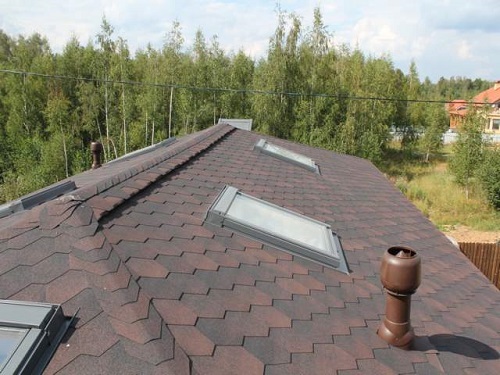
Taking into account all the above, the value of the angle of the roof inclination is calculated, being guided by the range from 9 to 60 degrees. Designers, as a rule, make the appropriate calculations and usually stop at values that range from 20 degrees to 45 degrees.
Why is such an angle of inclination of the roof attractive? The fact that you can use any roofing material - metal, corrugated board, slate, etc. Nevertheless, each material for the finish coat has its own requirements, which are taken into account when constructing a roof structure.
If you chose roll materials as the roofing, then when laying in 2 layers of material, the roof inclination angle should be up to 15, and with a three-layer laying - from 2 to 5 degrees.
- The use of deposited materials is most suitable when the roof has a slope of 0-25%. When the slope is 0-10%, then the material must be stacked in three layers. If the value of the angle of inclination is in the range of 10-25%, one layer can be dispensed with, but the material should be sprinkled.
- Asbestos cement corrugated sheets (slate) are covered with roofs having a roof slope of up to 28%.
- Tiles are used when the roof has a slope of at least 33%.
- The steel cover is laid on the roof with an inclination angle of less than 29%.
The material consumption directly depends on the slope of the roof. The bigger it is, the higher the consumption of the finish material. As a consequence, a flat roof in this respect will cost less than a roof that has an inclination angle of 45 degrees.
If you know the size of the roof slope, then calculate the amount of necessary material is not difficult. The same can be said about the height of the roofing structure.
Let us dwell on each concrete form of the roofing.
After calculating the slope angle of a single-pitched roof, you simply lift one wall to the desired level, which will provide the calculated value of the angle of inclination.
Roof from metal
If you compare with other roofing materials, the metal tile has considerable weight. Therefore, when constructing a roofing structure with the application of such a finish coat, all nuances should be considered and try to build it so that it has a minimum angle of the roof slope.
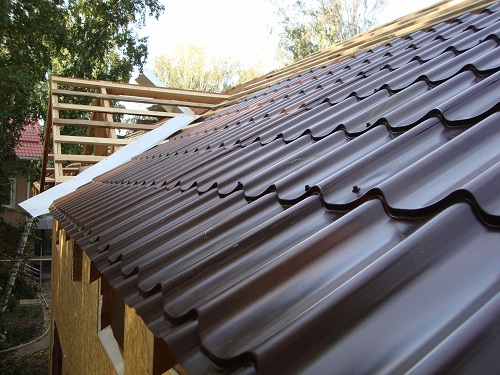
This issue deserves special attention in areas with very strong winds. As you know, the load from the wind has a strong and negative impact on the roof. Calculation of the roof structure in this case must be done especially carefully. When the angle of the roof is large, a "swelling" of the roof can occur, which will cause an increase in the load, which will affect the entire structure. In turn, this can lead to premature destruction of the roof.
Roofs, which are covered with metal, should have a minimum value of the angle of inclination within 22 degrees. Empirical evidence suggests that due to this indicator, moisture accumulation at the joints of the roofing is prevented. There is their protection from undesirable seepage of water in the form of thawed snow or rain.
Important! The minimum roof slope, when there is such a need, can be at least 14 degrees. If soft tiles are used as the coating, the minimum value is reduced to 11 degrees. In this case it would be correct to arrange an additional continuous crate.
Roofing made of corrugated board
About profiled sheeting, it is known that it takes the place of one of the most popular roofing materials. Everyone knows its advantages in the form of light weight and ease of installation. It is not difficult to mount profiled sheets on the roof.
Important! It should be noted that when installing such a roof, the requirements for a minimum angle of slope of the roof are more than 12 degrees (see the manufacturers recommendations).
Roofing with roll "soft" materials
When the roof is made of soft roofing, it is a roofing material, ondulin, polymer (membrane) roofing. When deciding how to calculate the angle of the roof, the following is taken into account:
- Number of covering layers. Depending on them, the angle of inclination of the roofing structure can be from 2 to 15 degrees.
- When covering in 2 layers it would be good to stop at the angle of the roof slope of 15 degrees. For a three-layer it is enough to have a slope within 2-5 degrees.
- Membrane coatings, which are optimal for any type of roof, including the most complex in its geometry, are laid on roofs having a slope of 2-5 degrees.
No doubt, the angle of the roof will be chosen by the owner of the building. He must take into account that the roof is designed for temporary and permanent loads. The atmospheric precipitation and their weight are temporary. They can be classified as wind, which exerts pressure on the roof structure and directly the finish coat. When constant loads are mentioned, then we are talking about the weight of the roofing structure itself and the material of the finish coat.

From the slope of the roof depends such a constructive element of the roof, as the crate - its type, step and design. For example, the lower the angle of inclination, the shorter the step of the crate in the roofing system. The minimum slope of the roof provides for the step of the crate, which is 35-45 centimeters.
One of the main questions is the question of the amount of material for the finish coat, which must be calculated and purchased. There is a tendency to see this: a larger roof slope requires more material consumption.
I would like to offer some practical tips that will be useful in selecting materials for the roof:
- with a slight slope of the roof (less than 10 degrees), the roof can be covered with a material that contains stone crumb or gravel (5 mm thickness for crumbs and 15 mm for gravel).
- when the angle of the roof slope is more than 10 degrees, then a basic waterproofing device is required from the bitumen. If roll materials are used, additional protection must be used. Such a coating, as a rule, is a color.
- roofing with such roofing material as corrugated board or asbestos cement sheets, provides for sealing of butt welds. Joints in this case are made double.
Calculate the angle of the roof
Calculation of the angle of inclination of the roof depends on the height of the ridge. What is the height of the roof in the ridge, depends on the functional purpose of the attic space.
When a full attic room is made from the attic, the angle of inclination is calculated as follows:
For example, the end of the roof (the width of the pediment) is 6 meters. This figure is divided in half (6: 2 = 3). The height of the roof in the ridge is always as standard as 1.8 meters.
Sin A = a / b = 3 / 1.8 = 1.67
With the help of the Bradys table there is an approximate value that has a roof slope angle at a value of Sin A = 1.67 - this value is in the range of 58-59 degrees. You can stop at a maximum of 60 degrees, which will be our desired angle of inclination of the roof slope.
Probably you will be interested: Stretch ceilings above the clouds Zaporozhye Stretch ceilings.
Depending on the type of roofing material used, the angle of inclination of the roof is selected. To quickly remove water from the roof slopes, the designer needs to take a certain slant. This important parameter can be expressed either by the ratio of the legs, you probably met the notation like ½ or 1/3, they can also be expressed using percentages. Next, we will discuss in more detail how to calculate the angle of the roof and select for certain materials.
Slope of roof slope and roofing materials
For the construction of pitched roofs, various materials can be used, which determine the angle of the ramp. The most common are asbestos-cement sheets, cellulose-bituminous (these two are also called slate), soft tiles (other names are bitumen, shingles), roofing material, metal tile, ceramic, cement tiles, etc.
The least slope of the roof is considered the most economical, since the hypotenuse is always longer than its legs. Therefore, it is often the task of determining the minimum angle of inclination of the roof. The more tightly the joints of the material, the closer it is, the smaller the slope can be used. If it has sealed joints, then the wind will not blow out the moisture under them. If the material is sufficiently dense, it will withstand heavy loads from precipitation, so it can be placed more gently.
Above you are given a graph on which the blue lines denote roof slopes with certain roofing materials. To determine which maximum and minimum slopes have some materials, use the table below. We note at once that the slope indicates the angle of inclination of the slope with respect to the horizon. It can be large, then the roof will be called steep or small, then the roof will be called flat. As already written above, the slope of the skates can be expressed in dimensionless quantities or in the form of degrees and percentages. It is most convenient to use precisely dimensionless quantities, since only roulette is needed for this. If, for some reason, carpenters do not know the height of the ridge, they can calculate it by themselves. To do this, they measure the distance between the supports, that is, recognize the length of the span, find the middle and measure up half (at a slope of 1/1), a third (at a slope of 1/3), or another value.
A semicircular scale indicates the ratio in degrees, and the vertical scale in percent. Use this graph can be used as a basis to calculate the minimum angle of inclination of the roof of the house. A thick line indicates a slope of 50%. Note that the vertical segment h, which acts as the skate of the house, is placed in the other larger leg twice. Note that the angle of inclination of the hypotenuse, that is, the roof of the house is represented by the ratio of height to its location.
i = height h / (1/2) = 2.5 / (12/2) = 5/12, or in another way 5: 12. To represent this bias in percentages, this ratio must be multiplied by 100. We get the expression: 5: 12 * 100 = 41.6666%. As we see, 41.666% is the minimum angle of the roof slope.
Maximum and minimum roof inclinations of different roofing materials
The table is made on the basis of normative documents and practical experience. Remember that the market of building materials is constantly updated, along with it, and the possible angles of fastening materials and their load-bearing capacity. Thus, when choosing a particular roofing material, ask the manufacturer for the rules of its installation or use the enclosed instruction, if any.
| Roofing material | Minimum angle of inclination of the roof slope | Maximum angle of inclination of the roof slope | |||||
| Weight 1 m ^ (2), kg | Aspect Ratio | In percentages | In degrees | Aspect Ratio | In percentages | In degrees | |
|
angle of slate roof - asbestos-cement sheets of medium profile |
11 | 1/10 | 10% | 6 ° | 1/2 | 50% | 27 ° |
| asbestos cement sheets of reinforced profile | 13 | 1/5 | 20% | 11.5 ° | 1/1 | 100% | 45 ° |
| cellulose-bituminous corrugated sheets | 6 | 1/10 | 10% | 6 ° | and more | ||
| soft, flexible, bituminous shingles, shingles | 9–15 | 1/10 | 10% | 6 ° | and more | ||
| galvanized sheet metal with single folds | 3–6,5 | 1/4 | 25% | 14 | and more | ||
| corner of the roof made of tin - galvanized sheet metal with double folds | 3–6,5 | 1/5 | 20% | 11.5 ° | and more | ||
| roof angle from ceramic tiles | 50–60 | 1/5 | 20% | 11.5 ° | 1/0,5 | 200% | 64 ° |
| roof angle of cement shingles | 45–70 | 1/5 | 20% | 11.5 ° | 1/0,5 | 200% | 64 ° |
| corner of the roof made of metal | 5 | 1/5 | 20% | 11.5 ° | and more | ||
To skilfully translate from percentages to degrees, you can use a conversion table using the table below.
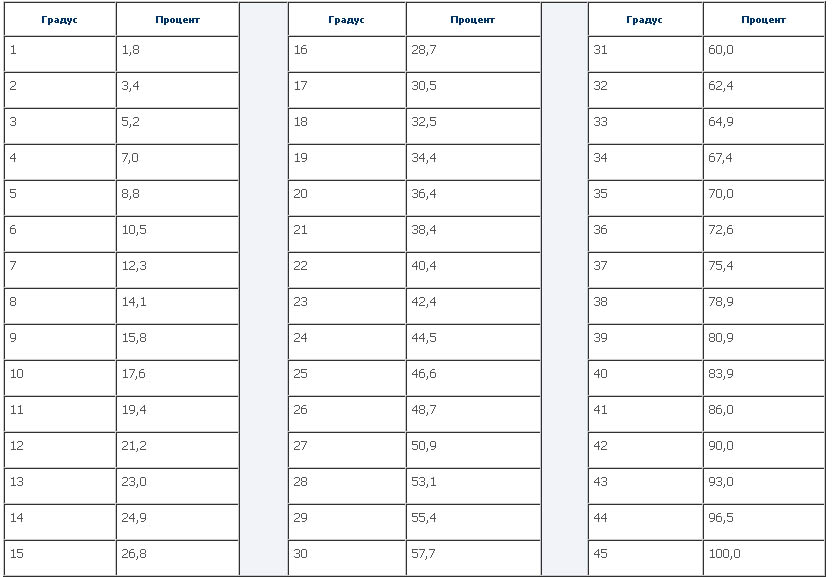
The tables at the top allow you to quickly navigate in gradients expressed in percentages and degrees, and also determine the minimum and maximum values of the roof slopes. Let me remind you that the angle of the roof is different for most roofing materials and depends on the strength characteristics, because the materials have to withstand considerable loads and, in addition, to remove the required amount of precipitation.
How to calculate the height at a known angle of inclination of the roof
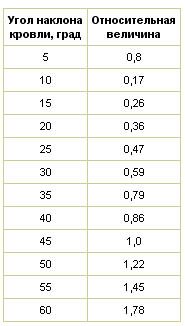
How to find the height of the skate at home? To do this, remember the simple formula: half the span is multiplied by the relative value shown in the image below. For example, if the width of the house span is 12 m and the required gradient is 30 degrees, then the height of the ridge will be: 12/2 * 0.59 = 3.54 (0.59, because on the plate below this value should be taken for the angle of the roof in 30grad).
